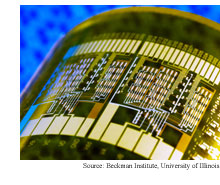
 |
 |
 |
 |
Cut
nanotubes speed flexible circuits
 Cut
single layers of overlapping, randomly oriented carbon nanotubes into strips
and you've got an inexpensive route to high-performance, flexible electronics.
Cut
single layers of overlapping, randomly oriented carbon nanotubes into strips
and you've got an inexpensive route to high-performance, flexible electronics.
Carbon nanotube networks have been embedded in plastic in previous attempts to form flexible circuits, but the electronics were either short-circuited by metallic nanotubes in the mix or required that the metallic tubes be weeded out to leave just semiconducting tubes. Scoring parallel lines into the nanotube layers to break the chains of connected metallic nanotubes turns out to be a good way to cut down on short circuits.
Prototypes flexible computer circuits include an 88-transistor device. The method could be used to make flexible displays and sensor array skins.
Research paper:
Medium-scale Carbon Nanotube Thin-film Integrated Circuits on Flexible Plastic Substrates
Nature, July 24, 2008
Researchers' homepages:
Rogers Research Group
Ninad Pimparkar
Nanoelectronics Research Laboratory
Moonsub Shim
Muhammad A. Alam
Related stories and briefs:
Spinning out nanotube transistors -- a flexible circuit method that involves removing metallic nanotubes
Nanotubes form transparent film -- a precursor flexible nanotube film
Back to TRN August 4/11, 2008
View from the High Ground Q&A
How It Works
RSS Feeds:
News
Ad links: Clear History
Buy an ad link
© Copyright Technology Research News 2000-2010. All rights reserved.